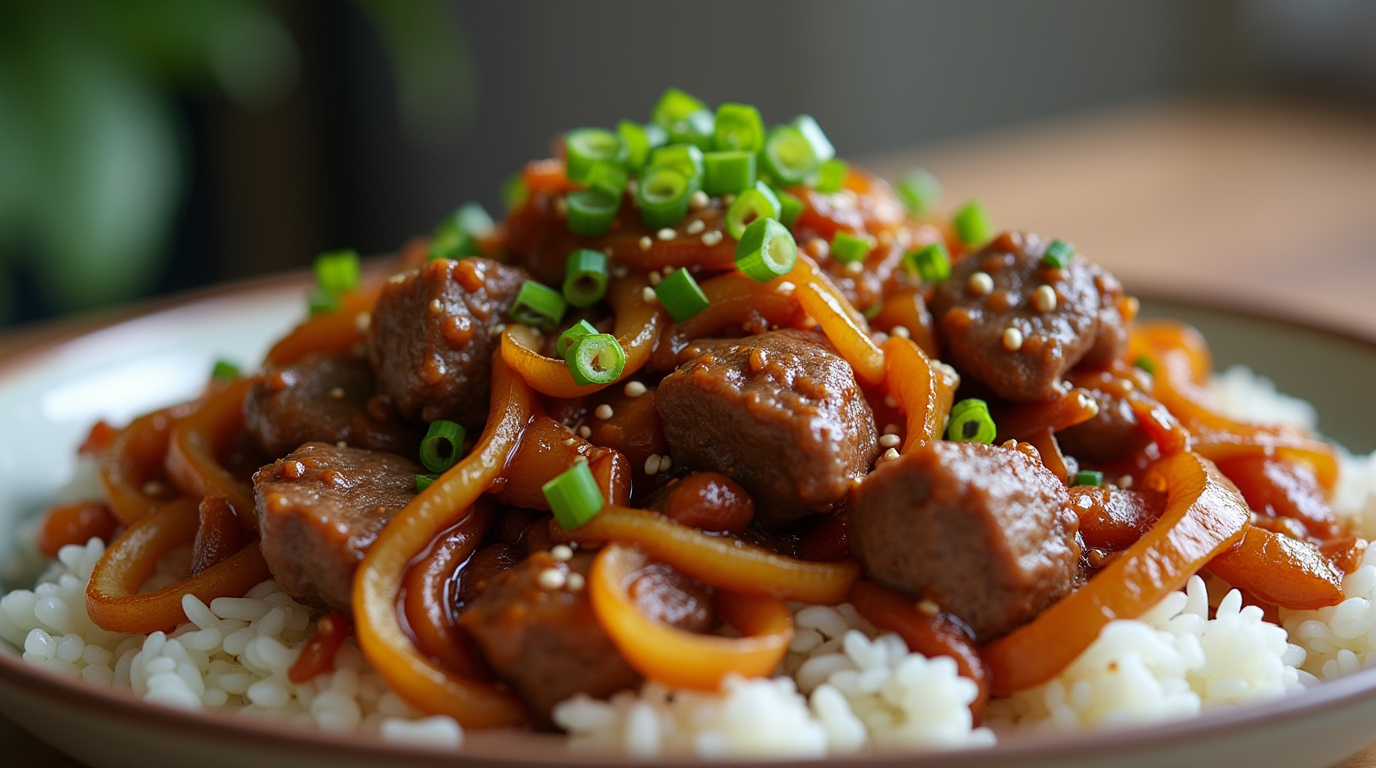Chinese Beef and Onion Stir Fry is a classic dish that is beloved for its simplicity and full flavor. With just a few ingredients—primarily beef and onions—this dish can be whipped up in less than 20 minutes, making it perfect for weeknight dinners. It’s a popular takeout item, but you can easily prepare it at home with healthier ingredients and the same satisfying taste. For a more detailed breakdown, visit our comprehensive guide on Chinese Beef and Onion Stir Fry.
Why Chinese Beef and Onion Stir Fry is Popular
There are a few reasons why this dish has become a staple in homes and restaurants alike:
- Fast and easy preparation: It takes minimal time, from slicing the beef to stir-frying the onions.
- Nutrient-rich: With its protein-packed beef and fiber-rich onions, it’s both filling and nutritious.
- Versatile: You can modify it with additional vegetables or different sauces to suit your preferences.
For those who prefer tender, flavorful beef in their stir fry, learning how to tenderize beef is essential. This technique will ensure your beef stays juicy, even when cooked quickly over high heat.
Ingredients Overview
The core ingredients of Chinese Beef and Onion Stir Fry are simple, but each plays a crucial role in the flavor and texture of the dish. You can check out our in-depth ingredient guide in our Chinese Beef and Onion Stir Fry Recipe.
- Beef: Opt for cuts like sirloin, rib eye, or flank steak, which work well for quick stir frying.
- Onions: Both white and yellow onions are suitable, though white onions add a slightly sweeter taste.
- Additional ingredients: Garlic, soy sauce, and oyster sauce enhance the umami flavor. You may also want to include ginger or hoisin sauce for added depth.
Understanding how to cook with a wok is just as important as selecting quality ingredients. Using proper wok cooking techniques ensures high heat distribution, which is vital for achieving the perfect stir fry texture.
Key Cooking Techniques for Stir Frying
Stir frying is all about high heat and fast cooking. Here are a few essential tips:
- Prep before you start: Have all ingredients sliced and ready, as the cooking process moves quickly.
- Thinly slice the beef: Cutting the beef against the grain in thin slices ensures it cooks quickly and remains tender.
- High heat: Use a high flame to cook the ingredients rapidly without overcooking them.
How to Get the Perfect Beef and Onion Stir Fry:
- Slice the beef thinly and marinate it with soy sauce, oyster sauce, and cornstarch to lock in moisture.
- Stir fry the beef quickly on high heat, just until it browns, then remove from the pan.
- Add sliced onions and garlic to the wok, stir frying until the onions become translucent.
- Return the beef to the wok, adding any remaining sauce, and cook until everything is coated and heated through.
Traditional vs. Modern Variations
While the traditional recipe focuses on just beef and onions, there are plenty of modern twists to try:
- Classic version: The traditional stir fry consists of beef, onions, and a soy-based sauce.
- Modern takes: Add vegetables like bell peppers, carrots, or even broccoli to the dish for extra color and nutrition.
- Sauce variations: Consider using black bean sauce, hoisin sauce, or even a spicy szechuan sauce for a different flavor profile.
For those looking for a plant-based alternative, you can easily substitute the beef with tofu or other plant-based meat options. These alternatives can offer similar textures and flavors, especially when paired with the same seasonings and sauces.
Serving Suggestions
Chinese Beef and Onion Stir Fry is incredibly versatile when it comes to how it’s served:
- Side dishes: Serve it over steamed rice or noodles for a complete meal.
- Garnishes: Top the stir fry with green onions or sesame seeds for added texture and flavor.
- Beverage pairings: This dish pairs well with light beverages such as green tea or a cold beer.
Common Mistakes to Avoid
Even though this dish is simple, there are a few common mistakes that can affect the final outcome:
- Overcooking the beef: Stir fry beef quickly on high heat to avoid it becoming tough.
- Too much sauce: Adding too much liquid can lead to a soggy stir fry. Keep the sauce light to maintain texture.
- Not using high heat: Stir fry needs a very high temperature to cook the ingredients fast without losing their crunch and texture.
Health Benefits and Nutritional Breakdown
Not only is Chinese Beef and Onion Stir Fry delicious, but it also offers some great nutritional benefits:
- Protein-rich: Beef is an excellent source of protein, which helps with muscle repair and satiety.
- Low in carbs: This dish can be made low-carb by reducing the amount of sauce or serving it with a side of vegetables instead of rice.
- Vitamins and minerals: Onions provide antioxidants and vitamin C, while garlic adds additional immune-boosting properties.
For those looking to make the dish healthier, consider using a leaner cut of beef, reducing the oil, or swapping soy sauce for a low-sodium version.
Frequently Asked Questions (FAQs)
What cut of beef is best for stir fry?
Cuts like sirloin, flank steak, and rib eye are the best because they’re tender and cook quickly.
How do I prevent my beef from becoming tough?
Slice the beef against the grain and cook it quickly over high heat to ensure it stays tender. Marinating it with cornstarch and soy sauce also helps retain moisture.
Can I use frozen beef for stir-fry?
Yes, but make sure to fully thaw the beef and pat it dry before stir frying to avoid excess water in the pan.
What other vegetables can I add to my stir fry?
Common additions include bell peppers, broccoli, snap peas, and carrots. These add both flavor and nutritional value.
Is Chinese Beef and Onion Stir Fry gluten-free?
To make it gluten-free, substitute soy sauce with tamari or use a gluten-free soy sauce alternative.
Conclusion
Chinese Beef and Onion Stir Fry is a quick, flavorful, and nutritious dish that anyone can master. Whether you prefer to stick with the traditional recipe or get creative with vegetables and sauces, this meal is versatile enough to please any palate. By following the steps above and avoiding common mistakes, you’ll have a delicious, restaurant-quality stir fry in no time. Be sure to explore our complete guide for more tips and tricks.


16 thoughts on “Chinese Beef and Onion Stir Fry: A Delicious and Quick Recipe”